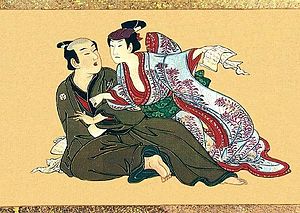Miyagawa Isshō



Miyagawa Isshō (Japanese: 宮川一笑) was a Japanese painter in the ukiyo-e style, primarily depicting kabuki actors, geisha, sumo wrestlers, and other elements of everyday urban culture. He was a pupil of Miyagawa Chōshun (1682–1752), who, in turn, was influenced by the works of Hishikawa Moronobu. Like many ukiyo-e artists, Isshō also produced a number of shunga, paintings of erotic scenes.
Isshō is known to have been banished from Edo in 1751, along with his master Chōshun, to the island of Niijima for the period of a year. This came after a dispute arose over the payment for a painting commission in Nikkō. A Kanō school artist commissioned Chōshun to paint some of the walls of the Nikkō Tōshō-gū but refused or was unable to pay. In the ensuing confrontation, the Kanō artist was killed, quite possibly by Isshō.
